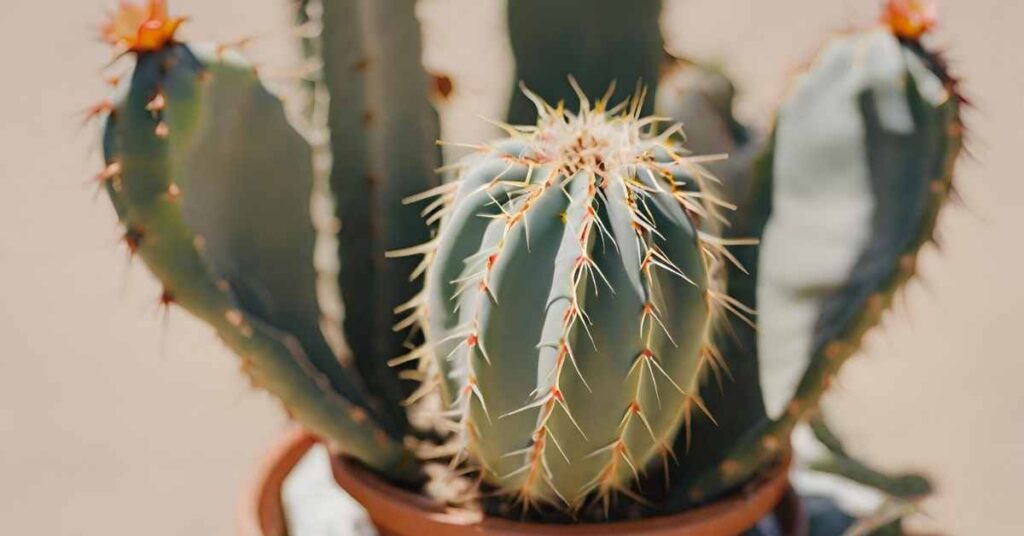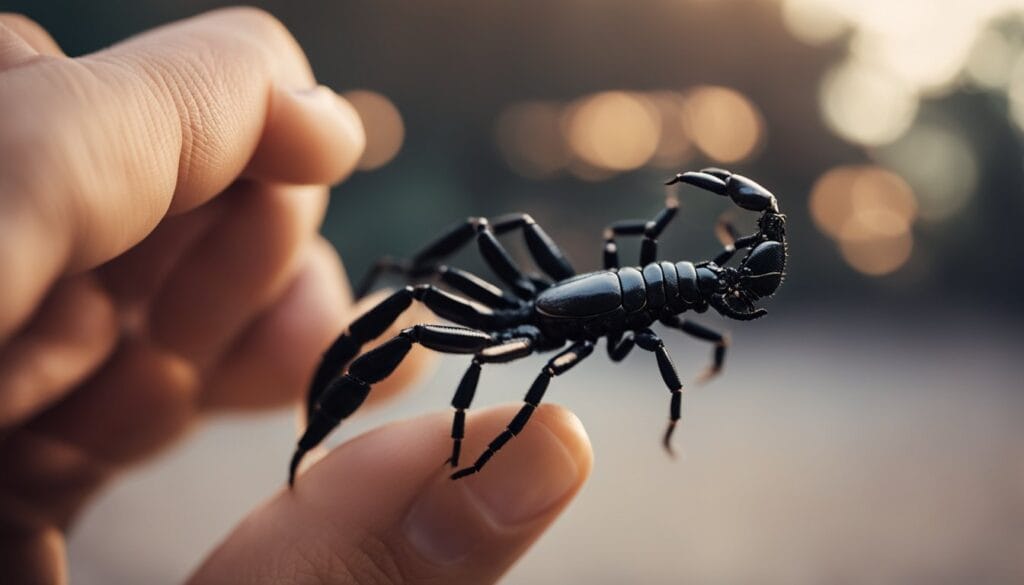Cacti have often been seen as a symbol of endurance and resilience, rising from the arid and unforgiving landscapes where few other plants dare to thrive. But have you ever pondered the deeper spiritual significance of these spiky plants?
Across various cultures, cacti are not just admired for their tenacity but for their profound spiritual meanings. They are entities that tell tales of adaptation and protection, offering silent wisdom from their desert realms.

In many traditions, the cactus represents more than just a resilient survivor; it embodies the sacred interplay between the earthly and the divine. For some, like the indigenous peoples of the Americas, the cactus plant, particularly those like the Peyote and San Pedro, are gateways to spiritual realms, facilitating a connection with higher powers and inner consciousness. Even in modern homes, we find cacti as stewards of positive energy, thriving amidst the chaos of daily life and reminding us of the balance between our environment and our spirit.
Key Takeaways
- Cacti symbolize both physical endurance and profound spiritual significance.
- They play a sacred role in various cultures, often used in spiritual practices.
- The presence of cactus plants in homes may represent a harmonious balance between our environment and spiritual well-being.
Historical Significance and Cultural Perspectives
You may have seen cacti lined up on a windowsill or thriving in arid landscapes, but have you ever considered their deeper meaning? From symbolizing endurance and protection in various cultures to playing crucial roles in ceremonies, cacti aren’t just spiky plants—they’re storied symbols of spirituality and tradition. Let’s explore this rich tapestry.
Cultures and Traditions
Cacti hold a special place in Native American life, especially within the traditions of indigenous tribes like the Huichol. For these cultures, the peyote cactus is sacred, playing a central role in rituals and ceremonies for its hallucinogenic properties that are believed to lead to spiritual awakening and healing.
Key traditions involving cacti:
- Vision quests: Often involving the peyote cactus, as a means to connect with spiritual realms.
- Healing rituals: Utilization of cactus for medicinal purposes and spiritual restoration.
Feng Shui and Spirituality
In Feng Shui, cacti are known to be a bit controversial—while they’re admired for their tenacity and survival skills, their sharp thorns can also be seen as repellant of positive energy. However, when placed in areas that attract wealth or support personal growth, they’re believed to absorb negative energy and protect your space. Think of cacti as nature’s barbed wire, keeping the unwanted at bay while supporting tenacity and resilience.
Feng Shui tips with cacti:
- Place in wealth areas to deter negative energy.
- Avoid the bedroom or places of relaxation to maintain harmony.
Folklore and Myth
Ever heard of someone dreaming of a cactus? It might not just be a random dream; in the language of symbolism, it could mean a longing for protection or an innate desire to establish boundaries. In various folktales, cacti symbolize the ability to protect oneself or stand tall against adversity—the ultimate green warriors of the plant kingdom. They are metaphors for enduring harsh conditions with grace and standing strong despite the odds.
Cactus folklore highlights:
- Protection: A common theme in stories depicting cacti standing guard.
- Endurance: Used as metaphors for surmounting tough life challenges.
As you’ve just seen, the cactus is more than just a hardy houseplant. It carries with it millennia of culture, beliefs, and spiritual significance. Whether as a totem for perseverance in Native American spirituality or an emblem of protection in folklore—this resilient plant has a storied past echoing through the sands of time.
Biological Characteristics and Survival Mechanisms

Ever wondered how cacti thrive in conditions that would wither other plants? The resilience of these prickly wonders is a fascinating convergence of evolutionary ingenuity and biological tenacity. Let’s explore the traits and tactics that make cacti the ultimate survivors of the plant world.
Adaptations to Harsh Conditions
Cacti are champions of endurance, boasting an array of adaptations that allow them to flourish in some of the planet’s most unforgiving environments. These adaptations are more than just survival tricks; they’re a masterclass in botanical resilience.
- Thick Stem: Cacti have a thick, fleshy stem that stores water, giving them a hefty reserve to tap into during droughts.
- Reduced Leaves: Their spines are actually modified leaves which not only reduce water loss but also provide some shade from the harsh sun.
These biological features ensure that even in the most barren and dry landscapes, cacti stand tall and hydrated. Have you ever felt like you carry too much water weight? Well, if you were a cactus, that would be your superpower!
Defense Mechanisms and Protection
Now, what about those spines that have prickled your fingers more times than you’d like to admit? Cacti’s spines serve as their ultimate defense mechanism.
- Sharp Thorns: Acting as a formidable barrier, the sharp thorns deter hungry animals looking for a juicy bite.
- Prickliness: This feature is not just for offense; it also provides a shield against the scorching desert sun, diffusing the intense light to protect the stem underneath.
Imagine trying to hug a porcupine – that’s how predators feel about cacti. This prickliness isn’t just for show; it ensures a cactus’s survival against the threats of the wild. Isn’t it amazing how cacti combine toughness with a water-saving lifestyle to beat the odds in nature’s harshest environments?
So next time you look at a cactus, don’t just see a plant with needles; see an extraordinary example of survival, perfectly equipped to endure the extremes. Remember, it’s not about having the sharpest thorns in the desert, but about how you use them to protect your precious resources!
Symbolic Meanings and Interpretations

Cacti are not just prickly plants that thrive in arid environments; they’re rich with spiritual symbolism. They tell stories of resilience and hold ancient wisdom. Let’s explore some of the profound meanings attached to these hardy survivors.
Cactus as a Symbol of Strength
Strength and perseverance are the hallmarks of a cactus. Have you ever noticed how cacti stand tall against the scorching sun? They represent the ability to withstand tough conditions and serve as a metaphor for inner strength. Their presence reminds us that, like them, we are capable of weathering our own deserts – those tough times in life.
Healing and Medicinal Significance
Beyond their spiny exterior, cacti have a history of being used for healing and medicinal purposes. When you think of a cactus, consider its ability to store nourishing water and provide relief. The cactus’s association with healing isn’t just a physical notion but extends to spiritual tranquility too.
Representation of Personal Boundaries
Ever feel the need to set personal boundaries? Well, cacti are nature’s boundary-keepers with their protective spines. They teach us the importance of creating a safe space for ourselves to foster personal growth and trust. A reminder that sometimes, it’s okay to say no.
Cactus in the Landscape of Life
The cactus stands as a symbol of adaptation and the ability to thrive in the harshest landscapes. They symbolize growth, productivity, and prosperity, showing us how to adapt and make the most out of our surroundings. When life gives you deserts, be like a cactus — find your way to flourish!
Each point in the life of a cactus, from its enduring nature to its surprising ability to bloom, serves as a guidepost for spiritual awakening and enlightenment. Just like the cactus, may you find energy and determination to continue your personal journey towards transformation and interconnectedness with the world.
Cactus in Home and Environment

Cacti bring a unique blend of ornamental beauty and natural warmth to any space, creating a sense of balance and harmony. Whether you’re looking to spruce up your home decor or transform your landscape, these resilient succulent plants are versatile and full of character.
Cactus for Home Decor
Ever thought how a plant could redefine the feel of your home? Cacti have a knack for doing just that! With their varied shapes and sizes, these spiky beauties are perfect for adding a touch of nature to your interior spaces. Here’s why you should consider them:
- Ornamental Appeal: Cacti come in an astonishing variety, each with its unique form that can complement any room’s aesthetics.
- Feng Shui: Many believe that cacti can bring feng shui benefits to a home, like absorbing negative energy and offering protection.
Example of cacti as home decor:
- A tall Saguaro cactus becomes a living sculpture in your living room corner.
- A collection of small, colorful Echinopsis cacti on a shelf can liven up any space.
Did you know some cacti even bloom with flowers? Quite a sight!
Cactus in Landscaping
But what about outside, under the great, wide sky? Cacti are not just for inside your home; they can make your garden truly stand out. Let’s dig in:
- Landscape Integration: Cacti can seamlessly fit into a variety of garden styles, from rock gardens to modern minimalist landscapes.
- Water Conservation: As drought-tolerant plants, cacti are excellent for creating water-wise gardens.
Tips for using cacti in your landscape:
- Use bold, large cacti as focal points in a garden to draw the eye.
- Incorporate cacti with different textures and heights for a visually intriguing landscape.
So, are you ready to welcome these desert dwellers into your home and garden? With just a little care, they’ll be happy to share their quiet strength and serene beauty with you.
Practical Uses and Benefits

Cacti aren’t just spiky plants that thrive in the desert – they’re powerhouses of benefits that go way beyond mere ornamentation. From their medicinal properties to their nutrition-rich fruits, let’s explore how these resilient plants can be surprisingly good for you.
Medicinal Properties and Healing
Cacti have been part of traditional medicine for centuries, valued for their healing properties. For example:
- Certain species contain compounds that are used in modern medicine for their analgesic and antispasmodic effects.
- The alkaloids found in some cacti can promote faster wound healing and have been traditionally used to treat burns, cuts, and skin ailments.
Cactus in Diet and Nutrition
You might be surprised to find cactus on your plate, but it’s actually a nutritious addition to your diet. Highlights include:
- Nopales (prickly pear pads) are low in calories but packed with vitamins, minerals, and fiber which contribute to overall nutrition and sustenance.
- The fruits of some cacti contain antioxidants and are often eaten or made into beverages for a nutritional boost.
Ornamental and Therapeutic Value
Besides their practical uses, cacti also enhance our lives aesthetically and psychologically:
- Many varieties can be grown indoors which adds a touch of nature to your home and has been suggested to improve mental well-being.
- Engaging with plants, including care for cacti, can be a form of therapy, promoting relaxation and reducing stress levels.
Cactus Flowers and Reproduction

Cactus flowers embody resilience and beauty, surprising many with their bright blooms. Let’s uncover how cactus flowers contribute to both the symbolism and the reproductive cycle of these tough plants.
Blooms and Their Meanings
Have you ever marveled at the stunning flowers a cactus can produce? These vibrant cactus flowers are not just a visual treat; they symbolize endurance in harsh environments. It’s as if each bloom is a little nod of encouragement, whispering “keep going.” For many, they represent hope—blooming against the odds in the most unforgiving conditions.
Fruitfulness and Posterity
In the harsh desert, cacti stand as icons of fruitfulness. It’s fascinating, isn’t it? Who would have thought that those spiky plants can bear fruit? But they do, and these fruits are a testament to the cactus’s ability to sustain and propagate life in the arid wilderness. After the flowers have been pollinated, they often give way to fruits, which can be both a source of nourishment for wildlife and a means of spreading cactus seeds. It’s this fruitful feature that symbolizes the potential for new beginnings and continued legacy.
Understanding Cactus Varieties

Have you ever wondered about the different kinds of cacti that dot our arid landscapes? Let’s get up close and personal with these prickly companions and discover the diversity they offer.
Types of Cactus Plants
Cacti come in more shapes and sizes than you might imagine! Did you know there are about 2,000 different species of cactus? They’re part of the plant family Cactaceae, which is widely known for its variety of succulent plants that store water. These desert dwellers range from the towering Saguaro cactus, famed for its classic cactus silhouette, to smaller, spherical varieties like the chin cactus. Each type has adapted ingeniously to thrive in the desert, making them some of the most resilient plant species out there.
Distinctive Features of Common Cacti
Now, let’s zoom in on some attributes these spiny characters share and what makes each one stand out.
Saguaro Cactus (Carnegiea gigantea): Towering over 40 feet, the saguaro is the quintessential desert plant, often seen in Western movies. It has a long lifespan, sometimes reaching 200 years, and develops arms as it ages.
Chin Cactus (Gymnocalycium): This globular small fry is known for its ‘chin-like’ protrusions and dainty flowers. It’s quite the charmer on a sunny windowsill!
Each cactus has developed features like spines for water preservation and protection from predators, thickened flesh for storing water, and root systems designed for efficient water absorption. Whether you pick a towering saguaro or a petite chin cactus, you’re surely in for an intriguing encounter with one of nature’s most fascinating creations.
Spiritual Practices and Cactus

Cacti are not just spiky plants that thrive in the desert; they hold deep spiritual significance and are often used in practices aimed at personal growth and spiritual awakening. Let’s dive in and uncover how these resilient plants can guide you to inner peace and self-discovery.
Cactus in Meditation and Healing
Have you ever sat down to meditate and felt a little off-balance? Cacti might just be the nature’s helpers you’ve been looking for. Known for their ability to thrive in harsh environments, they symbolize endurance and the quiet strength needed to overcome challenges.
- Resilience: The cactus stands as a symbol of being able to persist and bloom despite difficulties, making it a powerful ally in meditative practices focused on healing.
- Balance: Incorporating cactus plants into your meditation space can promote a sense of grounding and stability, fostering an environment conducive to achieving inner peace.
By having a cactus present during your meditative practices, you can draw on its silent strength as a means to fuel your journey towards healing and harmony.
Cactus as a Tool for Personal Discovery
Ever wonder what your purpose is or where your path is leading you? Look to the cactus for some answers. Their existence in solitude mirrors the journey of self-discovery, teaching us to look within.
- Improved Focus: Emulating the cactus’s independent growth can encourage a deeper internal reflection necessary for spiritual awakening.
- Spiritual Symbolism: In many cultures, cacti are seen as protectors, warding off negative thoughts and providing clarity to one’s direction in life.
By reflecting on the existence of cacti, you can find parallels in your own life, helping you uncover truths about your own nature and potential for growth. Embrace the silent wisdom of these resilient plants, and you just might find they lead to profound personal insights.
The Cactus as Gift and Symbol

When you think of a cactus, you might picture a resilient plant thriving in a harsh desert. But did you realize that giving someone a cactus can be a deeply symbolic gesture, with meanings ranging from perseverance to maternal love?
Gift Giving and Its Implications
Have you ever received a plant as a gift and thought about what it means? Gifting a cactus is more than just handing over a prickly plant – it’s a sign of appreciation and a wish for good fortune. Let’s unpack this:
- Perseverance: A cactus symbolizes endurance through tough times.
- Maternal Love: The plant’s ability to sustain itself mirrors a mother’s enduring love.
- Good Fortune: Some believe that cacti bring protection and positive energy.
Cactus as a Metaphor for Life
Sometimes life can be tough, right? Well, a cactus stands as a testament to that, symbolizing the beauty of persisting even in challenging conditions. It’s not just about survival; it’s about blooming with grace when the going gets tough.
- Self-Sufficiency: Just as a cactus retains water for long periods, you too can hold onto your inner strength.
- Growth: Against all odds, a cactus finds a way to grow, reminding us that growth is possible in even the least expected places.
Next time you consider a cactus as a gift, remember the rich layers of meaning it carries. From a token of good luck to an emblem of unconditional love, this spiky plant has a lot to say!
Environmental Impact and Ecosystem

Did you know that cacti are not just spiky spectacles in the desert, but also pivotal to their ecosystems? These resilient plants have adapted remarkable traits to thrive and shape the environment around them.
Cactus in the Global Ecosystem
Cacti are key components in their habitats, providing crucial support for a variety of wildlife. Their role includes offering:
- Shelter: Cacti create microhabitats for small animals and insects.
- Food: Their fruits and flowers are a source of nourishment for birds and mammals.
Specifically, the reduced ecosystem services of desert plants from ground-mounted solar energy development highlight how changes in land use can significantly affect these important plants and, by extension, the animals that rely on them.
Adaptation and Climate
The cacti’s ability to adapt to harsh climatic conditions is just fascinating. Here’s how they do it:
- Transpiration: Cacti have reduced their transpiration to conserve water, opening their stomata at night instead of during the day, which is a process known as CAM photosynthesis.
- Carbon Dioxide: They store carbon dioxide at night for use in photosynthesis during the day, helping them to survive in low-water environments.
Their unique adaptation mechanisms make cacti masters of survival, influencing both carbon and water cycles within their ecosystems.
Cactus and Modern Life

In a world that’s always rushing, have you ever wondered how a plant, like the cactus, holds deep meanings that reflect our contemporary struggles and growth? Let’s dive into how this spiky green friend mirrors the essence of resilience and self-discovery in modern times.
Cactus as an Emblem of Modern Challenges
Imagine starting each day surrounded by harsh sun and scarce water, yet still thriving – that’s the cactus for you. Perseverance personified, isn’t it? These plants stand tall amidst adversity, much like how we face our daily grind.
- Tolerance: Just as cacti can endure extreme temperatures, we too learn to adapt to the heated moments life throws our way.
- Productivity: Against all odds, cacti flourish, reminding us to make the most of our resources, however limited they may seem.
Think about it: when was the last time you pushed through a seemingly impossible situation and came out stronger? You’re more like a cactus than you realize!
Personal Growth and the Cactus Metaphor
Now, let’s talk growth – your growth. Cacti don’t just survive; they bloom with the most beautiful flowers, akin to us finding joy in our own journey of personal development.
- Individuality and Uniqueness: No two cacti are the same, and your path is just as unique, carved out by your own individuality.
- Patience: Growth takes time, and just as a cactus patiently waits for rain, we too must be patient with our own processes.
Cacti even have personal boundaries made of spines, teaching us to protect our space and energy. Ever felt prickly when someone oversteps? That’s you, setting your boundaries, cactus-style!
Consider these lessons as you navigate the complexities of modern life. Reflect on how traits like resilience and growth are not just concepts, but lived experiences, symbolized by our green amigo, the cactus. Feeling inspired to embrace your inner cactus yet?
Handling and Care of Cactus Plants

Cacti are renowned for their easy-going nature and resilience, making them perfect for patient gardeners aiming for a touch of long-lasting greenery. Here’s how to ensure your spiky friends thrive and cheer up your space safely.
Growing and Nurturing Cactus
Cactus Care: Your cacti love the sun and well-draining soil. Follow these tips:
- Sunlight: Place them where they’ll soak in plenty of indirect sunlight.
- Watering: Be sparse; water only when the soil is dry to the touch to avoid root rot.
- Soil: Use a mix specially formulated for cacti with proper aeration and drainage.
Remember, nurturing these plants is a slow yet rewarding process. You’ll need patience, but the pay-off is a robust, sculptural plant that can bring a unique sense of happiness to your surroundings.
Safety and Precautions
Handling cacti requires a bit of know-how to avoid their prickly defenses:
- Wear Gloves: Thick gardening gloves can protect you from sharp spines.
- Gentle Repotting: Use tools like tongs to handle cacti when repotting to keep both you and the plant safe.
Understanding and respecting these safety measures ensures your cactus care experience is joyful and free of any thorny mishaps. Stay safe and enjoy the company of your resilient green companion!
Conclusion

The cactus plant, often seen as just a prickly part of the desert landscape, has a depth of spiritual meaning that might just surprise you. Have you ever considered a cactus plant more than a tough survivor? Well, it turns out that many see it as a symbol of unwavering endurance and the ability to thrive in challenging environments.
- Resilience: Like a true warrior of the plant kingdom, the cactus stands tall, powering through the harshest of conditions. It’s a lesson in perseverance, don’t you think?
- Protection: Those spikes aren’t just there to make a point (pun intended). They’ve been interpreted as a form of spiritual protection, guarding you from negative vibes.
- Adaptability: No water? No problem. Cacti are the poster children for adaptation. Changing and growing, no matter what life throws your way, is a pretty powerful message from such a spiky friend.
In different cultures, the spiritual aspect of cacti blooms just as vividly as their rare, beautiful flowers. From the shamanic powers of the Peruvian San Pedro cactus to the healing journeys supported by peyote, these plants have been revered and utilized in spiritual practices for eons.
Remember, the next time you encounter a cactus, take a moment to appreciate its silent wisdom. This unassuming plant could teach you the arts of spiritual defense, resourceful living, and, most importantly, blooming where you are planted. Isn’t that a refreshing perspective to hold onto?




